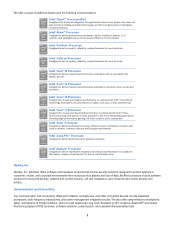Intel 2014 Annual Report Download - page 18
Download and view the complete annual report
Please find page 18 of the 2014 Intel annual report below. You can navigate through the pages in the report by either clicking on the pages listed below, or by using the keyword search tool below to find specific information within the annual report.Our sales to distributors are typically made under agreements allowing for price protection on unsold merchandise and a right of
return on stipulated quantities of unsold merchandise. Under the price protection program, we give distributors credits for the
difference between the original price paid and the current price that we offer. Our products typically have no contractual limit on
the amount of price protection, nor is there a limit on the time horizon under which price protection is granted. The right of return
granted generally consists of a stock rotation program in which distributors are able to exchange certain products based on the
number of qualified purchases made by the distributor. We have the option to grant credit for, repair, or replace defective
products, and there is no contractual limit on the amount of credit that may be granted to a distributor for defective products.
Distribution
Distributors typically handle a wide variety of products, including those that compete with our products, and fill orders for many
customers. Customers may place orders directly with us or through distributors. We have several distribution warehouses that are
located in proximity to key customers.
Backlog
Over time, our larger customers have generally moved to lean-inventory or just-in-time operations rather than maintaining larger
inventories of our products. As our customers continue to lower their inventories, our processes to fulfill their orders have evolved
to meet their needs. As a result, our manufacturing production is based on estimates and advance non-binding commitments from
customers as to future purchases. Our order backlog as of any particular date is a mix of these commitments and specific firm
orders that are primarily made pursuant to standard purchase orders for delivery of products. Only a small portion of our orders
are non-cancelable, and the dollar amount associated with the non-cancelable portion is not significant.
Seasonal Trends
Historically, our net revenue has typically been higher in the second half of the year than in the first half of the year, accelerating
in the third quarter and peaking in the fourth quarter.
Marketing
Our global marketing objectives are to build a strong, well-known Intel corporate brand that connects with businesses and
consumers, and to offer a limited number of meaningful and valuable brands in our portfolio to aid businesses and consumers in
making informed choices about technology purchases. The Intel Core processor family and the Intel Quark, Intel Atom, Intel
®
Celeron
®
, Intel
®
Pentium
®
, Intel Xeon, Intel Xeon Phi, and Intel
®
Itanium
®
trademarks make up our processor brands.
We promote brand awareness and preference, and generate demand through our own direct marketing as well as through
co-marketing programs. Our direct marketing activities primarily include advertising through digital and social media and
television, as well as consumer and trade events, industry and consumer communications, and press relations. We market to
consumer and business audiences, and focus on building awareness and generating demand for new form factors such as
tablets, Ultrabook devices, and 2 in 1 systems powered by Intel. Our key messaging focuses on increased performance,
improved energy efficiency, and other capabilities such as connectivity, communications, and security.
Purchases by customers often allow them to participate in cooperative advertising and marketing programs such as the Intel
Inside
®
Program. This program broadens the reach of our brands beyond the scope of our own direct marketing. Through the
Intel Inside Program, certain customers are licensed to place Intel logos on computing devices containing our microprocessors
and processor technologies, and to use our brands in their marketing activities. The program includes a market development
component that accrues funds based on purchases and partially reimburses customers for marketing activities for products
featuring Intel brands, subject to customers meeting defined criteria. These marketing activities primarily include advertising
through digital and social media and television, as well as press relations. We have also entered into joint marketing
arrangements with certain customers.
Intellectual Property Rights and Licensing
Intel owns significant intellectual property (IP) and related IP rights around the world that relate to our products, services, R&D,
and other activities and assets. Our IP portfolio includes patents, copyrights, trade secrets, trademarks, trade dress rights, and
maskwork rights. We actively seek to protect our global IP rights and to deter unauthorized use of our IP and other assets. Such
efforts can be difficult, however, particularly in countries that provide less protection to IP rights and in the absence of harmonized
international IP standards. While our IP rights are important to our success, our business as a whole is not significantly dependent
on any single patent, copyright, or other IP right. See “Risk Factors” in Part I, Item 1A, and “Note 25: Contingencies” in Part II,
Item 8 of this Form 10-K.
13
























